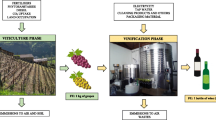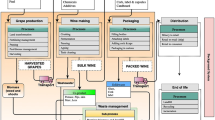Abstract
Background, aim, and scope
This paper presents the results of the LCA of wine production in the region of La Rioja (Spain). The aim of this study was twofold: to identify the most critical life cycle stages of an aged Spanish wine from the point of view of the associated environmental impacts and to compare its environmental performance with that of other wines and beers for which comparable information could be found in the scientific literature. All the product’s life cycle stages were accounted for, namely: grapes cultivation (viticulture), wine making and bottling, distribution and sales, and disposal of empty bottles.
Materials and methods
Foreground data were directly obtained from wine producers, farmers, and oenologists; background data were instead sourced from the GaBi professional database. In order to limit the uncertainty and subjectivity of the results, the choice was made to only employ midpoint indicators of environmental impact (global warming potential (GWP), acidification potential, eutrophication potential, photochemical ozone creation potential), in addition to gross energy requirement (GER) and water demand (WD). The calculated environmental indicators were allocated to the following co-products on the basis of the associated economic revenues: wine, pomace, lees, and press syrup. The avoided impacts associated to electricity generation were accounted for according to the displaced marginal technology.
Results
The GWP of Rioja wine was found to lie between 900 and 1,000 g(CO2-eq)/bottle, depending on the assumed distribution scenario. GER is around 8–9 MJ/bottle, and WD is approximately 5 kg/bottle. The most relevant life cycle stages from the point of view of most of the considered impact categories were found to be viticulture (and fertilizer use in particular) and the production of glass for the bottles. Transportation of the wine and final disposal of the empty bottles cumulatively account for a maximum of 30% of the overall impact, depending on the specific indicator and the assumed distribution scenario.
Discussion
The analysis appears to be in good agreement with previous literature studies, the results of which lie within a comparatively narrow range. Within such range, the more upmarket Rioja wine can arguably be seen as providing a greater net benefit to the economy per unit of impact.
Conclusions
The present analysis has shed light on which are the two main environmental bottlenecks in the life cycle of industrialized wine, namely viticulture and glass production for bottle manufacture; GWP results are in the same range as those from previous literature studies. New insight is also provided on a possible measure of “economic return on environmental investment.”
Recommendations and perspectives
As it stands, the study presented here is arguably among the most complete and transparent analyses in the alcoholic beverage sector. It could be further enhanced at a later stage by also including those secondary sub-processes which were cut off due to lack of available data (including herbicides and pesticides). As for cross-comparability, it would be recommendable for all authors to never omit presenting their results in terms of transparent, disaggregated impact indicators.




Similar content being viewed by others
References
Aranda A, Scarpellini S, Zabalza I (2005) Economic and environmental analysis of the wine bottle production in Spain by means of life cycle assessment. Int J Agr Resour Govern Ecol 4(2):178–191
Consejo Regulador de la Denominación de Origen Calificada Rioja. (2008). Memoria 2008.
Cordella M, Tugnoli A, Spadoni G, Santarelli F, Zangrando T (2008) LCA of an Italian Lager Beer. Int J LCA 13(2):133–139
El Corte Inglés (2008) http://www.elcorteingles.es
GaBi (2007a) GaBi 4 software. http://www.gabi-software.com
GaBi (2007b) GaBi professional database. http://documentation.gabi-software.com
Garnett T (2007) The alcohol we drink and its contribution to the UK’s Greenhouse Gas Emissions: a discussion paper. Centre for Environmental Strategy, University of Surrey, UK
Guinée J (ed) (2002) Handbook on life cycle assessment. Operational guide to the ISO standards. Kluwer Academic Publishers, Dordrecht, the Netherlands. ISBN 1-4020-0228-9
INE (2001) Instituto Nacional de Estadística. http://www.ine.es [consulted 04/2009]
ISO (2006) International Organization for Standardization 14044:2006—Environmental Management. Life Cycle Assessment. Requirements and Guidelines
Koroneos C, Roumbas G, Gabari Z, Papagiannidou E, Moussiopoulos N (2005) Life cycle assessment of beer production in Greece. J Clean Prod 13:433–439
Milà i Canals L (2003) Contributions to LCA methodology for agricultural systems. Site-dependency and soil degradation impact assessment. PhD thesis in Environemntal Sciences, Autonomous University of Barcelona, Spain. http://www.tesisenxarxa.net/TDX-1222103-154811/
Pintprice (2008) http://www.pintprice.com [consulted 04/2009]
SAWIA (2004) Australian Wine Industry State of the Environment 2003. South Australian Wine Industry Association Incorporated, Australian Government Department of Environment and Heritage and Winemakers’ Federation of Australia. http://www.wfa.org.au/PDF/Environment2003.pdf
Talve S (2001) Life cycle assessment of a basic lager beer. Int J LCA 6(5):293–298
Waste Online (2005). http://www.wasteonline.org.uk [consulted 04/2009]
Weidema BP (2001) Avoiding co-product allocation in life-cycle assessment. J Ind Ecol 4(3):11–33
Acknowledgment
The authors wish to acknowledge the financial contribution of the European Commission to the LIFE SINERGIA PROJECT, LIFE 03 ENV/E/0085. Thanks are due to M.J. Clavijo, M. Puerta and M. Tubilleja from the Dirección General de Calidad Ambiental de la Consejería de Turismo, Medio Ambiente y Política Territorial del Gobierno de La Rioja (DGCA), for their help in sourcing the necessary information on the viticulture and wine-making processes.
Author information
Authors and Affiliations
Corresponding author
Rights and permissions
About this article
Cite this article
Gazulla, C., Raugei, M. & Fullana-i-Palmer, P. Taking a life cycle look at crianza wine production in Spain: where are the bottlenecks?. Int J Life Cycle Assess 15, 330–337 (2010). https://doi.org/10.1007/s11367-010-0173-6
Received:
Accepted:
Published:
Issue Date:
DOI: https://doi.org/10.1007/s11367-010-0173-6




